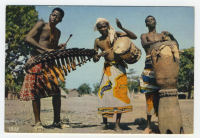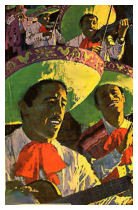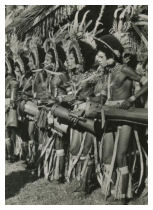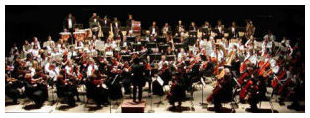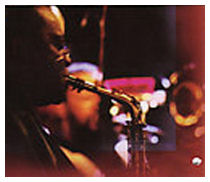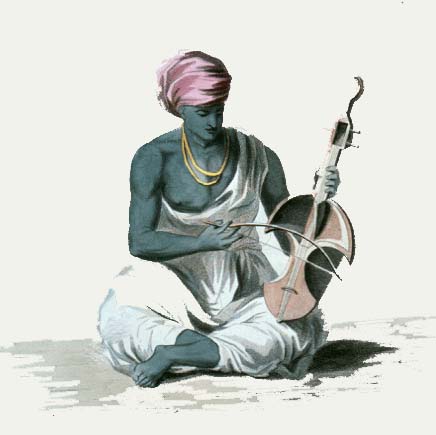Galleries
Africa
Africa is the world’s second largest continent with more than 900 million people, making it the second most populated continent after Asia. There are 54 independent and sovereign countries including Madagascar and the island groups, with over 850 native languages. Climates in Africa range from tropical to sub arctic, with desert and arid regions in the northern half, to the savanna plains and very dense jungle (rainforest) regions in the central and southern areas. One of the richest and most dynamic art forms of Africa is the indigenous musical and dance traditions, maintained over the centuries through oral tradition. Today, much of the musical styles “in” Africa, include a mixture and blend of the highly traditional complex dance rhythms and choral singing with modern popularization trends. Throughout history, a wide variety of musical instruments have supported the culturally rich mosaic music of Africa.
Asia
The Asian instruments in this collection come from the world’s largest regions, bound to the east by the Pacific Ocean, the north by the Arctic Ocean, and the south by the Indian Ocean. To the west, it extends to Europe. This region is home to 60 percent of the world’s population that include sub-regions of varied cultures. The four principal regions represented in this collection are South Asia, Eastern Asia, Northern Asia (Ex-USSR), and Western Asia (Middle East).
The musical instruments of Asia, serve to demonstrate important aspects of the social, spiritual, and aesthetic values of their cultures of origin. They are made from various indigenous materials and bear evidence of uses in a variety of contexts, both religious and secular.
Central & South America
Music of Central and South America includes many diverse styles of indigenous, European, and African influences of the past. Today, it is generally accepted that the term Latin-American encompasses the Americas south of the United States, as well as the entire Caribbean.
The musical instruments of this vast area will be discussed in terms of pre-Columbian, colonial, and present day Latin America. The diversity of this area includes regions of major cosmopolitan cities, ruins of great ancient civilizations, tropical rainforests, the pampas of Argentina and one the longest mountain ranges in the world, the Andes Mountains of west coastal South America.
Oceanic/Pacific
Oceanic may be defined in a number of ways. Geographically, it collectively includes the countries and subregions of Australia, New Zealand, Papua New Guinea, in addition to numerous volcanic islands of the South Pacific Ocean, such as, the Solomon Islands, New Caledonia, the Marshall Islands, Guam, Wake Island, Easter Island, Marquesas, and numerous others. Ethnologically, these islands are divided into four subregions of Australasia, Melanesia, Polynesia, and Micronesia.
The tension and vitality of the people in this region of the world, is reflected in the skillful construction of their musical instruments. These instruments were made to accompany the telling of stories, and the singing and chanting of songs, as it is from these sources of knowledge that history of the old traditions and cultures were told and preserved.
Native American
The Native Americans are not one people, they are many people and their music is the very foundation upon which their cultural heritage is built. The spiritual force that moves them to sing is the same force behind the other arts and the religions of the aboriginal cultures.
Kurt Sachs wrote: “Such music cannot be bought in stores, but comes from faithful tradition or from personal contributions of tribesmen. It is never soulless or thoughtless, never passive, but always vital, organic, and functional: Indeed it is always dignified. As an indispensable and precious part of culture, it commands respect. And respect implies the duty to help in preserving it.”
The (musical) instruments of the Native North Americans were made from the natural resources of their regional environment
Europe & the United States
Europe and the United States gallery contains a range of western world instruments dating from the late 1700’s to the mid-1900’s . The main emphasis in this gallery is on the instruments produced by professional makers, workshops, and factories. Some of these instruments are the subjects of research, and are identified as the oldest known example, or as the only one to be in existence. A few regional folk instruments are included, along with some unusual and unique instruments that are rarely seen. This Western music palette of instruments is grouped as follows: Aerophones (Winds): Brass and Woodwind Instruments; Chordophones: Strings (Bowed and Plucked) and Keyboards; Membranophones/Idiophones: Percussion (Definite and Indefinite Pitch); and Electrophones: Electronic Instruments.
American Jazz
Includes some of the most amazing and rarest of 20th century jazz instruments, including the double bell Jazzophon, the Saxotrumpet, and a soprano slide saxophone by Reiffel & Husted. This gallery is divided into Rhythm Section, Horns, and American Jazz Musicians. This last category, American Jazz Musicians, pays tribute to the professional musicians who have made distinguished contributions to jazz and to the preservation of this American phenomenon in St. Louis, and around the world.
Middle East & North Africa
Middle East is a term that remains unsettled. It has often been referred to as the crossroad of the world, because it connects the three continents of Asia, Africa, and Europe. This gallery website will include a variety of countries that include the Middle East and North Africa (MENA), including Algeria, Bahrain, Egypt, Iran, Iraq, Israel, Jordan, Kuwait, Lebanon, Libya, Morocco, Omen, Palestine, Qatar, Saudi Arabia, Syria, Tunisia, Turkey, Yemen, and the United Arab Emirates. It is believed that the harp, lyre, zither, drum and tambourine were all developed in the Middle East.

